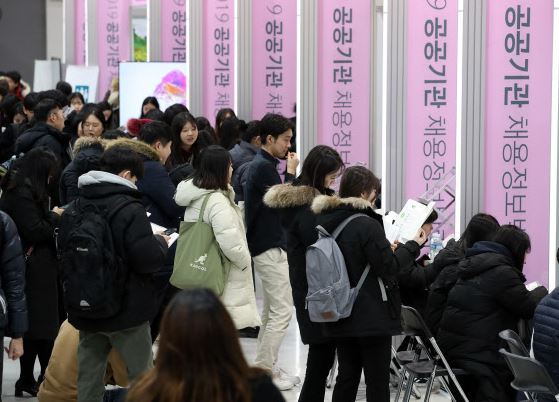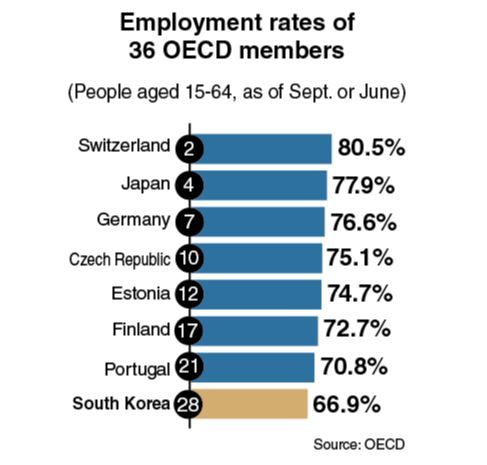[News Focus] Of 36 OECD countries, Korea stands at No. 28 in employment
By Kim Yon-sePublished : Nov. 27, 2019 - 15:29
SEJONG -- For South Koreans who say they do not support the incumbent administration, jobs are one of the main reasons cited in polls.
President Moon Jae-in’s detractors say the government’s labor policies consist largely of pouring taxpayers’ money into the creation of temporary jobs in the public sector.
Critics point to figures showing improved employment rates for senior citizens, who gained temporary jobs at public institutions, but bleaker outcomes for those in their 40s in charge of households.
Undermining the Finance Ministry’s argument that employment is improving, global comparisons show that Korea lags behind major countries in terms of employment for people between the ages of 15 and 64, who are classified as part of the working-age population.
President Moon Jae-in’s detractors say the government’s labor policies consist largely of pouring taxpayers’ money into the creation of temporary jobs in the public sector.
Critics point to figures showing improved employment rates for senior citizens, who gained temporary jobs at public institutions, but bleaker outcomes for those in their 40s in charge of households.
Undermining the Finance Ministry’s argument that employment is improving, global comparisons show that Korea lags behind major countries in terms of employment for people between the ages of 15 and 64, who are classified as part of the working-age population.

The Organization for Economic Cooperation and Development maintains a database of employment rates for its 36 members for people in this age bracket.
Korea posted 66.9 percent as of September 2019, ranking No. 28 on the list. The OECD average was 68.7 percent.
The figure for Korea falls far behind the 77.9 percent reported in Japan, which stood at No. 4 on the list, as well as emerging economies such as the Czech Republic (No. 10), which posted 75.1 percent, and Estonia (No. 12), which recorded 74.7 percent.
Also among those that ranked higher than Korea were Lithuania (No. 16) at 73.0, Slovenia (No. 18) at 72.3, Latvia (No. 19) at 72.0, Hungary (No. 22) at 70.0, Slovakia (No. 26) at 68.2 and Poland (No. 27) at 68.0.
Iceland topped the list with 84.6 percent, followed by Switzerland with 80.5 percent and the Netherlands with 78.2 percent. Just behind Japan in a tie for fifth place were New Zealand and Sweden with 77.4 percent. Germany stood at No. 7 with 76.6 percent and Norway at No. 8 with 75.7 percent.
Most English-speaking countries posted employment rates above 70 percent. The UK stood at No. 9 with 75.1 percent, Canada at No. 13 with 74.5 percent, Australia at No. 14 with 74.4 percent and the US at No. 20 with 71.5 percent.
Not only was Korea’s employment rate below the OECD average, but it fell short of the averages for other major economic blocs as well. The 19 eurozone countries posted an average of 67.9 percent, the 28-member European Union 69.2 percent and the Group of Seven 71.8 percent.

In a similar vein, Korea’s youth employment rate was far below the OECD average. While the 36 OECD members’ average employment rate for those aged 15-24 was 42.3 percent, the corresponding figure for Korea stood at 26.3 percent as of September 2019, placing Korea at No. 31.
The corresponding figures for young workers in the US and Japan came to 51.4 percent and 47.6 percent, respectively. Mexico and Ireland respectively posted employment rates of 41.7 percent and 40.7 percent for the 15-24 age bracket.
The respective average youth employment rates for the eurozone, EU and G7 were 34.0 percent, 35.7 percent and 46.4 percent.
According to a report from a commercial bank, a large proportion of households headed by middle-aged people have suffered a sharp loss of income.
Of survey respondents aged 40-49 who reported a loss of income, Shinhan Bank said in its report, 38 percent attributed the problem to the loss of their jobs. Others mentioned pay cuts (29 percent) and business failures (13 percent).
According to the report, 55 percent of the surveyed householders were unprepared for the decline in their earnings.
And middle-aged workers face more layoffs as manpower restructuring via voluntary redundancy programs is actively underway in the conglomerate-based manufacturing and financial sectors.
Businesses’ main solution over the past decade or so has been to reduce costs through voluntary redundancy programs, also known as early retirement.
By Kim Yon-se (kys@heraldcorp.com)







![[KH Explains] Hyundai's full hybrid edge to pay off amid slow transition to pure EVs](http://res.heraldm.com/phpwas/restmb_idxmake.php?idx=644&simg=/content/image/2024/04/18/20240418050645_0.jpg&u=20240419100350)






![[From the Scene] Monks, Buddhists hail return of remains of Buddhas](http://res.heraldm.com/phpwas/restmb_idxmake.php?idx=652&simg=/content/image/2024/04/19/20240419050617_0.jpg&u=20240419175937)

![[KH Explains] Hyundai's full hybrid edge to pay off amid slow transition to pure EVs](http://res.heraldm.com/phpwas/restmb_idxmake.php?idx=652&simg=/content/image/2024/04/18/20240418050645_0.jpg&u=20240419100350)

![[Today’s K-pop] Illit drops debut single remix](http://res.heraldm.com/phpwas/restmb_idxmake.php?idx=642&simg=/content/image/2024/04/19/20240419050612_0.jpg&u=)